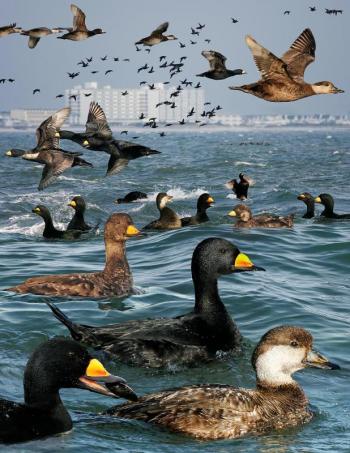Maine-Canadian Bird Connections: The Bounty of the Seal River Watershed
Cool Canadian air has descended upon us here in Maine this past week, bringing beautiful, sunny blue-sky days but nighttime temperatures dropping into the 30s. Many a gardener has brought out the tarps to cover the gardens in the hope of preventing a frost kill and coaxing a few more weeks growth from various late-fall vegetables and flowers.
With the cool air has also come numbers of some southward migrating bird species that we might have expected later in October. Among them are dark-eyed juncos, white-throated sparrows, palm warblers, and Swainson’s thrushes. Ducks will not be far behind. We’ve also already seen some waterfowl, like scoters and scaup, in a few spots; we expect those numbers will probably start building early with this weather.
A great majority of these birds began their southward migration from breeding grounds in the Boreal Forest region of Canada, where an estimated 1-3 billion birds nest and raise their young.
Last week a new report released by Ducks Unlimited Canada, Oceans North Canada, and the Manitoba Government described the results of surveys in one part of the Boreal Forest called the Seal River Watershed of northern Manitoba, where many of these birds could be originating. The Seal River Watershed is a 12-million-acre landscape of forests, wetlands, lakes, streams, and rivers that flows eastward more than 200 miles from near the Saskatchewan border to the ocean of Hudson Bay. The Seal River has no dams on its entire length, allowing both fish and the seals that follow them, to travel far inland, hence the river’s name. The new report details the number and variety of ducks and geese counted from low-flying airplane-based surveys from 2013-2015 in the easternmost part of the watershed.
The numbers are impressive and include many seaducks that we enjoy as part of our coastal wintering bird communities. Black scoters—the males, jet black with bright orange bills—were one of the most abundant of the breeding and migrating ducks documented in the report, with thousands estimated to occur in the area. Numbers of other seaducks and diving ducks were also impressive including long-tailed ducks, scaup (the aerial surveys could not differentiate between the two very similar-looking species) and, in migration, common goldeneye. Dabbling ducks such as green-winged teal, American wigeon, northern pintail, and mallards also were found in the thousands. The observers in the planes doing the surveys also noted loons and sandhill cranes. Interestingly, they documented both common loons and Pacific loons.
Clearly this report shows that the Seal River Watershed is a critically important breeding and migratory stop-over for huge numbers of waterfowl including lots of the species that we see regularly here in Maine.
Another publication, the Manitoba Breeding Bird Atlas, further highlights that the watershed’s landscape supports significant numbers of certain land birds, too, including many of those that have begun arriving this week here in Maine—white-throated sparrows, dark-eyed juncos, Swainson’s thrushes, and palm warblers among them.
Fortunately, a coalition of five Indigenous governments called the Seal River Watershed Alliance is working to establish a new protected area that would encompass this massive landscape, half the size of our entire state. Their efforts, if successful, will mean that millions of birds will have a vast landscape to nest and raise their young forever. Those same birds will migrate south from the Seal River Watershed to bring joy to birders across southern Canada and the U.S. including us right here in Maine. Hopefully this new report released by Ducks Unlimited Canada and partners will give the Manitoba government and the Canadian federal government even more resolve to follow the lead of the Indigenous governments of the Seal River Watershed Alliance as they work for protection of this amazing Boreal landscape.
Jeffrey V. Wells, Ph.D., is a Fellow of the Cornell Lab of Ornithology and Vice President of Boreal Conservation for National Audubon. Dr. Wells is one of the nation's leading bird experts and conservation biologists and author of the “Birder’s Conservation Handbook.” His grandfather, the late John Chase, was a columnist for the Boothbay Register for many years. Allison Childs Wells, formerly of the Cornell Lab of Ornithology, is a senior director at the Natural Resources Council of Maine, a nonprofit membership organization working statewide to protect the nature of Maine. Both are widely published natural history writers and are the authors of the popular book, “Maine’s Favorite Birds” (Tilbury House) and “Birds of Aruba, Bonaire, and Curaçao: A Site and Field Guide,” (Cornell University Press).
































